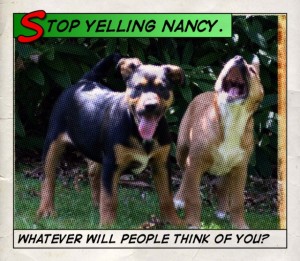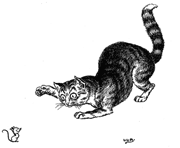Let’s talk about your social media presence rescuers.
I follow a lot of rescue groups on Facebook and on Twitter, mainly because I think of rescue as an industry, an ad hoc and somewhat shambolic industry, but an industry none-the-less. This means that I  like to know what is going on with other groups, see what good ideas they are having, see how they might be solving problems, marketing to adopters and communicating with the public.
like to know what is going on with other groups, see what good ideas they are having, see how they might be solving problems, marketing to adopters and communicating with the public.
However, I’m frequently surprised about how many groups, or the groups “representing” rescue groups pay so little attention to their social media presence. Sure they use social media, there must be more Facebook pages devoted to rescue groups, groups helping rescue groups and groups associated with rescue groups than there are cute kitty videos on the internet.
The problem is that, like Topsy, they just growed. Instead of treating their social media presence as the window display for their organisation, many rescue groups treat their Facebook page as the equivalent of a bower bird nest, full of random shiny stuff, some of it useful, much of it irrelevant.
Like it or not, rescue has pretty much gone mainstream. Thanks to Pet Rescue, rescue’s profile has never been higher. This means that rescues are competing with each other for fans, for donors and for adopters. And we’re competing against shelters that have marketing departments and communications specialists on tap.
It also means that presentation and reputation management have are increasingly important. In the early days of the world wide web, just having a web page, however amateur, was enough. But as the web became ubiquitous, web sites got glossier and more professional. Nowadays without a professional looking website and your own domain name you immediately look a bit amateur and not very competent.
So the question I’d like to ask rescue groups is, are you using your social media accounts well? Are you curating your content to deliver your message in the most effective way possible to your audience? Have you ever actually sat down and thought about what your message is, who your audience are, and what outcomes you’d like to achieve?
Have you thought about what public face you’d like the world to see, and how you want the world to perceive your group? Are you treating your social media accounts as a communication tool which can build and extend your reputation?
We all know that Facebook doesn’t let your audience see everything your post, but that your audience are more likely to see your posts if they engage with your content, through commenting, liking or sharing. Are you going to waste that valuable connection getting to people to share content which isn’t yours?
Ask some of your fans to look at your media sites and tell you what they like or don’t like. Ask someone who has some media savvy to give you feedback. Be critical and ask yourself whether your social media presence is telling your story, or just cluttering up people’s news-feeds.
Things I don’t want to see on your Facebook page.
- Dire warnings (your audience are already pet lovers, if you asked them they can tell you not to leave dogs in hot cars or hand pets over to random, passing strangers).
- Pictures of dead or injured animals (unless you’re asking for people to help and giving them a clear action they can perform, it’s just recreational outrage).
- Urgings to vigilante action (trial by Facebook is never going to end well, and many of the pictures of dog fighters or animal abusers which circulate are old, from another country or just wrong).
- Random advice about health or training (if you’re going to give training and health advice, makes it systematic, accurate and consistent).
- The latest cute, viral cat video (everyone loves a cute animal picture, a cat video or a funny tag on a photo, but by the time you put it on your page everyone will have seen it a dozen times. So make your own, create original content using your own adoptable animals).
- Diatribes about the irresponsible public and evil owners (nobody wants to hang out with people who do nothing but complain. Instead of highlighting the excellent qualities of the animals you’re trying to find homes for, you’re just continuing the idea that they are objects of pity).
- Fake statistics and trite sayings. (if you want to build a reputation, accuracy matters, and just because everyone else is saying it, doesn’t make it true or sensible – I’m looking at you, “don’t breed and buy while shelter dogs die”).
- Personal vendettas. (If you’ve got a problem with someone, take it off-line. Nothing says unreliable like emotional outbursts vilifying other people, including other rescue groups).
Things I do want to see on your Facebook page.
- Information about you, your group and what you’re doing. Rescues are interesting things, so tell the story about the work you’re doing and what’s going on with your rescue.
- Engagement. Encourage your followers to engage with you and make sure you engage with them by responding to questions or commenting on photos they post.
- Cute animal photos. I love a cute or funny animal picture as much as the next person, but share your own animals – that’s what you’re here for.
- Before and after photos and rehomed pets. Everyone loves a happy ever after story and showing off your pets in their new homes sends the message that you’re doing a good job.
- Good information, current research and advocacy, if they’re things you’re interested in. However, your page is there to get your pets adopted, so if you find yourself posting a lot of this kind of material, it might be worth setting up a separate page to share different kinds of content. This can be a good place to use alternate social media tools such as Twitter.
- Requests for help, donations and foster carers, as well as announcements about fund-raising events and activities. That’s what you’re on Facebook for, to spread the word.
- Thank yous. Highlighting the people who have helped you is not only a nice thing to do, but sends the message that you’re good people to work with.
- Mix it up. If you’ve got a good photographer in your group, use Instagram or Pinterest to create galleries of gorgeous photos. Think about how you might use Twitter (hint: nothing is duller than a Twitter account which simply repeats the content of your Facebook page).
- Professionalism. Remember that your Facebook page is your public face, and this includes reasonable spelling and punctuation. Presentation matters.
Here are some examples of people getting it right in different ways.
Rescued with Love: lots of lovely before and after photographs, a personal and intimate without being confessional tone and enough well-reasoned advocacy to make it clear where the group stands on issues.
Fetching Dogs: Gorgeous, gorgeous photographs, slick and minimal layout, minimal text, but sharp and funny.
S.A.H.A Horse Rescue and Sanctuary: lots of before and after shots as well as frequently updated information about the progress of the rescue horses.
Ingrid’s Haven: the cats are the stars and their stories and personalities make very engaging reading. It’s a low-key site, but concentrates on the message, which is cats make great companions.
Pug Rescue and Adoption: pugs are inherently entertaining, align cute pug photos with lame but very funny verse and you’ve got a page which is guaranteed to make you feel good.
The good news is that there are resources to help you get it right.
Webinars on social media for shelters and animal rescue groups: https://pro.petfinder.com/social-media-webinars/
Some simple rules to help non-profits make good use of social media. http://veevblogs.wordpress.com/2014/08/23/the-share-factor-10-ways-to-raise-awareness-by-making-your-content-viral-friendly/
How non-profits are using social media to engage with their communities: https://nonprofitquarterly.org/management/23837-how-nonprofits-use-social-media-to-engage-with-their-communities.html
